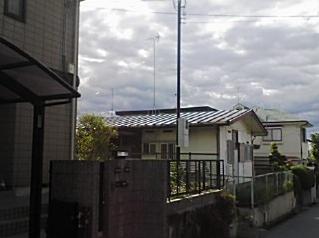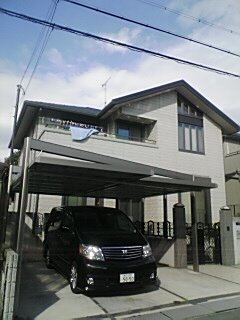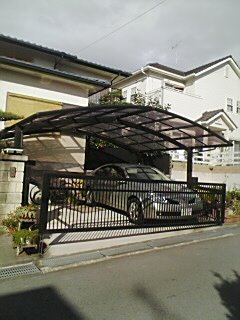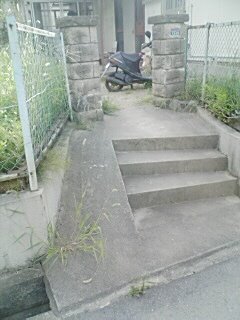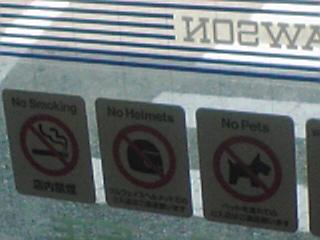Today, I accidently summited a mountain. That's right. Didn't really mean to.
Today was one of the few days over the next month that has absolutely nothing listed on my calendar. I slept in, practiced a little Japanese and Vietnamese, talked with my sister Nicole online. Nothing special really.
Just then, I got the itch.
No, not the itch to go have a visit with the neighbors annoying dog that I've now "affectionately" nicknamed "football." That's right, there was a bug on my leg. These things get into everywhere in Japan.
But, after shaking it off, there was another itch.
Adventure. Maybe I should go on a little adventure. I can go see more of Ao Yama, and if I am not too tired, perhaps I can go find that tourist attraction, the shrine up North about 10 kilometers...It was worth a shot. Maybe I could take some pictures of some of the odd-looking houses in the area, or some fabulous Japanese gardens. I head off with my white bicycle towards Ao Yama (The Blue Mountain) a neighborhood near mine. I haven't entirely figured out why it is called that, but I've gotten my share of ideas today. I coast down a low, long hill that is obviously a descent into the large valley east of Midori ga Oka (The Green Hill) and maybe is the road out the neighborhood known as Ao Yama. As I reach what I think is near the edge of Aoyama and the strip of habitated begins to narrow with forest closing in on both sides, I take a right at a "Cosmo" gas station, know by the big "O" logo. (They are a major gas company here in Japan.) I do this because I can see there is a fence, one of the ones that surrounds most of the populated areas along the edge of the forests of Hyogo, fences that need to be there to hold back the overpowering thick vegetatitive growth. I took a couple pictures, of the fence and the solution to running power through impassable forest, but those will be for another day.
I ride along the forest-edge, seeing if I can find a way through to the area where a certain memorial park is on the other side of the mountains. Along the way, however, I find, strangely enough, a break in the fence. It is about 6 meters across, perhaps, and has an old, but not particularly recently-used look about it. I drive away a little bit, then, reconsidering, turn back, hopping off my bike. I am already a bit tired from going back up the hill that I had coasted down for a few minutes (in tracing the wall of forest I had managed to get back up the hill that I had come down), but I decide to get off my bike (since it looks a little steep). This IS the first break in the growth that I have seen short of where they carved out land for houses and baseball fields and the like, and the first footpath not made of solid pavement is a new thing to me here.
I brace myself against the possiblity of spiderwebs and begin pushing my bike up the slight incline which quickly becomes a steep ascent. The path has a few switchbacks, and in the meanwhile the slope gets steeper and steeper, with slightly more spiderwebs as I go. I consider the possibility that, in the even that I want to come down, bringing the bike might not be so easy, especially since it was becoming quite a chore to not only keep my footing on the path but also to push the bicycle along with me in the meantime. The path begins to have less of the helpful tree-roots that had helped me more when the slope was less, and the partial growth that holds sandy soils and pebbly rocks in place begin to be my only hope of continuing without slipping and sliding down a short length of footpath into the webs of plants--and those of the big yellow and black spiders I have seen living in peoples' hedges and trees in their narrow front yards. Without pausing, continuing upward, I think about leaving the bike on the trailside. Except there is no trailside. I don't really have the ability to "park" it anyway, since the trail is steep, and besides the trail, there is only growth too think for me to place my bike. Even if I could park it, it would block the entire path, and I suppose, in reflection, that I could have hung it in a tree, but even in that case, I'd have had to get it down and taken it down the slope with me. Besides, what if this trail was still passable to its end? Trails don't lead to nothing, as long as they don't
completely overgrow. So I press onward--or...upward.
Eventually, I wearily come to an intersection. There is a much more suitable trail, with room for about 1 big person, 2 small ones, or a man and a bike abreast. Excellent. There is a dark, rust-brown fence of about shoulder height. This is obviously the major trail, and as I can see from the lay of the slope to either sides of the narrow trail, that this marks the crest of the ancient mountain. Many people are not aware of it, but much of the State of Washington has trails using this same method of trail-carving as in the Cascade Mountains. Luckily, these are not as pointy, and falling anywhere just means into brush. I have two options here: take the trail that leads downhill to my left, or the one uphill to my right. I pause to consider. The one to my right would take me to the vallley where that shrine is, but it might lead to a ford in the stream that is in between. I can't take my bike across a ford of any kind, and I don't feel like getting wet, so, right it is. Maybe there will be a softer slope leading downward into the town on the end of this trail. As might be said in Minnesota, "A guy can hope, anyway." As I push the bike up the
much more gradual slope, my feet slipping lightly as I go, I try to figure out how the vegetation is kept at bay. There is a slight scent to the earth, and it is here that I realize that perhaps they salt the soil or something similar. I notice something on the way-side.

It is a trailmarker! A footlength in stature and made of stone, it is the Kanji (whole/part word ideographic symbols) for "Three" and "Book." I think about it, and decide that these Kanji are probably Kanji at the beginning of a word on one of my maps of Miki, explaing why they look so familiar together. However, I can tell that they are NOT the symbols for Ao Yama, the neighborhood which I am southeast of, nor are these part of the name Midori ga Oka, which has a much, much more elaborate kanji. Miki? If this marker is for Miki, I consider, then this trail MUST be very long! The area of Miki only starts a couple kilometers south of here, but it stretches perhaps another 10 or so kilometers in the direction that the trail was pointing. For the trail to be labeled Miki so far away from the city proper, then this has to be a mark to tell travelers that they are in the Miki area. This is obviously also not a mark that they are near Miki proper for another reason: this stone marker is so old as to be from before the town below was related to Miki in any way besides perhaps being under the control of Samuai who ruled
from Miki.
Shortly ahead, I see that the trail splits, leading towards a better-lit area. Better lit means a break in the green-ness that is Kansai. Whether it is an outlook or a trail down, I'd certainly like to know. I head out onto a lumpy mound of pebble-rock, park my bike atop it, and take a picture of Ao Yama from a ways up, using my zoom to see through a better gap in the trees. As the phone's camera program produces an artifical shutter sound over the tiny speaker, another sound catches my attention:

My bike has fallen off the mound, upside-down into a bushy tree or tree-like bush. I haul it out and continue onward, enjoying my little jaunt in the wild enough that I am ignoring the heat despite the late-afternoon August hike up the seemingly endless ridge.
The insects that make loud noise constantly in all of Kansai, something like a huge (loud) cricket, have silenced themselves (or left) the part of the mountain crest I am continuing to push forward (and uphill). I have long since been unable to see the town, nor hear it, and I muse over the irony that it might be that the insects--the same insects that make so much noise, waking people up, keeping them awake, and generally irritating people much of the time--are actually only loud because they themselves are irritated at the presence of humans who have been in their forested lands and have left an open, unprotected sky in their wake. I spot another split in the trail. I see light and a clearing on the path to my right, so I immediately turn my bike that way. There is a bit more clear sky above from here, and in this place I find something unexpected on this clearing at the peak of the mountain: Shrines.
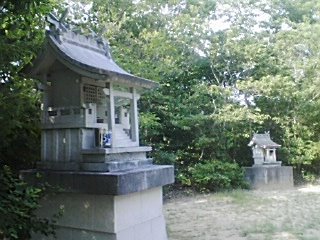

There appear to be two. I look at each of them, unsure how old they are, or who put them there. I suddenly realized that I am basically standing in the middle of a small cemetery. However, unlike a European one, it doesn't have a cold or dark feeling. These are
proud memoirs of people who have passed, people who have lived, and died. These are marks of
communal commitment by loved ones, both the living and the dead and...I still haven't seen anyone. And outside of the small clearing, spiderwebs are everywhere.
There is a railing opposite of the two shrines. It is an obvious post WWII contribution to the safety of the mourning, who, teary eyed might find themselves accidently standing and falling off the cliffside. It's hard enough when one person dies. Next to it is a gate.
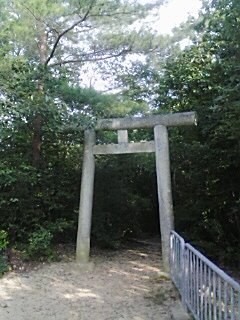
I think they are referred to by the Japanese as something like a Shidoo. It has rocks placed along the tops of the horizontal sections, each one some kind of symbol of spiritual contibution, I would gather. I look out over the cliff itself from near the railing and I note that I can once again see out over the town. I am very near Ao Yama Community Center and Saty (the most reasonable deparment store around). Seeing it below seems much farther away from where I stand. The contrast between the abandoned-looking site and the bustling city, unheard below with a quiet that is almost painful, keeps me there for a moment. I noitce, off in the distance, a blue looking mountian. This is the peak of a mountain, surely, and it hangs over the heart of downtown Ao Yama, so I
had figured upon arriving that this was Ao Yama. Now I see that there might be another alternative: This mountain that is not really visible from the valley bellow, is very readily visible here, on this very green hill.
So Ao Yama might be named after the view
not the location. Midori ga Oka, then, might be named after the hill 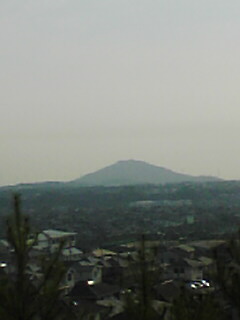 itself, or the next one over!
itself, or the next one over!Feeling ready to find out how green the next hill (nearer to Midori ga Oka village) was as well as to see what other treasures I can find, I decide to press onward, ignoring my fatigue and the heat. I turn, and look to see if the other split in the trail heads along the ridge further and to see if it intersects the path with the gate, and I notice another shrine. This one is so old that the bottom had crumbled, being propped up with a section of the broken original. There are Kanji along the length of it, vertically of course, since it is probably from well before the time of significant Western influence, if not earlier than any Western influence, which seems likely. However, it is so time-worn that even the stone itself cannot be read for it's Kanji easily, despite how deep it was originally etched. I doubt it is likely that if anyone has forgotten the name of this shrine, that anyone could determine the first name of the person by its remains, let alone his last name on the mostly intact section. I was perhaps lucky to have even noticed it, since the plantlife has grown a
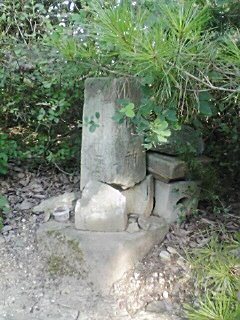
round it. The other two had reasonable clearing around them, and there is no sign of a clearing around this one as having ever existed.
Once again having the urge to move, I gather my bicycle and head down the trail, through the shrine. I barely duck in time to avoid the spiderwebs...well, I duck late enough that I only brush a few strands instead of something more. Another sign of either a low number of visitors or a huge, fast-acting population of spiders. Only a dozen or so steps later, something large
swoops down past my head with a flap of dark wings! I am quite certain immediately that it isn't any of the local birds
I have seen, due to its size. My head turns to follow it. It is a
butterfly!! More, it is probably the biggest one I have ever seen, living or under glass. It moves with wide, slower swoops, that remind me not of the local birds that I thought it might have been at first, but instead like the slow, strong swoops of a hawk. I can hardly believe my eyes, but as I fiddle with my phone to reopen it and activate the camera, it moves into the shrine area proper. It is fast, due to its size, so by the time I can get my camera ready it is gone again. Rats. Then as I close the camera it comes back out, immediately followed by my reopening of the camera. Finally, I follow it past the big shrine, deciding that I am leaving my phone open and camera-ready until either the battery dies or I am off this mountain. I follow it through a few-too-many spider webs, only gettting stuck by a few, until I notice that this minor, older path splits. To my right is
another shrine!
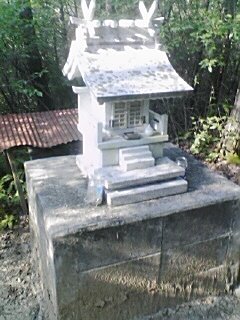
The butterfly is gone again, having disappeared in a single flap of the wings into the thick canopy. This shrine is entirely surrounded by spiderwebs, so, despite the nearby spider on its web, I leave my bike and duck very low holding my hand ahead of my as if I was going to karate chop someone on the neck. Strangely appropriate that I am in Japan and needing this. The light filters down on this shrine and into the small clearing just right that it puts an amazing, only slightly erie glow around the shrine itself. The camera can almost do it justice, I note, after I use my now-ready camera up for a photo.
Once again, I turn and head through the shrine-opening, retrieving my bicycle along the way.
At least this thing is good for clearing the lower spiderwebs as I walk. I spot a smaller butterfly of a gorgeous orange colour I may have never seen before and attempt to take a picture. I...mostly fail. It is below. I could only take a picture for a moment, and it was a moment with bad light streaming through the trees, poor lighting on the subject, and it was over the fence, a bit too far off. Well, I got
a pic
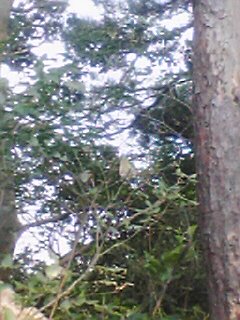
ture of a butterfly. Only a normal, American sized one. Funny that "American sized" here means smaller than Japanese. That is atypcial of almost everything on this island.
I continue onward, waiting for a large red bee that is hovering in the path to move. After edging up on it VERY slowly, it decides to move up the trail, and, lucky for me, off of it. I was starting to think that this slight downhill trail along the ridge that descended from the zenith would be continous, but it did as I thought might, and started to go back up again. Again I see a roadmarker. I take a photo. This one is in much worse condition and probably older. This impies to me that this mountain either allows for greater weathering due to it being bigger or that these markers have be moved based on territory, and that this trail is very, very old. There have been occasional breaks in the fence that is on only the one side of the road, revealing trails that have grown over, perhaps two out of the dozens that I have passed have been used in years, and some would not at first glace even be trails. If not for the gap in the fence, I would not have n

oticed that they had ever been trails, unless I was really looking, and then I'd probably only be able to guess by the fact that there is no
really old growth there, and only old growth.
Then, I am almost hit in the head by another monstrous, slow-flapping yet fast moving butterfly. Is this the same one? It doesn't look the slightest bit smaller, if anything it looks BIGGER! I move to take a photo but this time I only get one so blurred as to be completely worthless. I start to follow it, and again, it makes me backtrack along the trail. I once again leave the bike knowing I will certainly come back this way once I get one single good picture of this thing, if I ever can, if it ever lands for a moment. Glancing down for a split second to erase the last picture makes me
again lose track of the butterfly. Defeated, I return to my bike where, either the same one or yet
another gigantic butterfly flutters over my bike, more like a crow might hover over a new carcass, by its movement. Of course, in fast motion, its hovering side to side in low swoops are still too fast to catch on camera, and it refuses to leave right away, leaving me feeling mocked for a time as I wait with my lens focused roughly on it. Just when it looks like it is about to land, it flies of with only a few wingbeats and is gone.
After another good length of time, I spot another old marker, this one of a yellow stone.
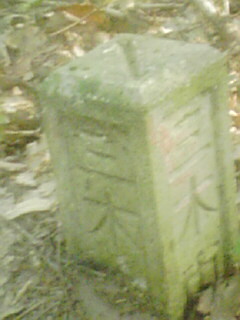
This one seems newer than that others. I also see that this one has something different about it...I can see that there is a third Kanji below the first two! And...it says Miki! So at least one of my hypothesis were right, it seems. This is way more fun than some reconstructed temple for tourists! I move on after yet another photo, only to see buried away fairly deeply in the forest floor, another marker. Two so close together bothers me for some reason, and when I look at the marker, I see that the stone has been stained red. My blood chills a bit as I look it. I don't know what happened here, but I get the feeling it was bad, and that is why they put in another marker. This one looks about the same as the other three, but...that blood-red stain and the fact that my camera doesn't want to focus on it is enough to get me moving fairly quickly. I move ahead. Another monstrous black butterfly with white spots on its wings almost hits me in the head.

Suddenly, I find myself with only a row of trees between myself and a gigantic water tower. It has wide spiral staircases along the sides of it, and is fenced off by a very tall and surdy-looking metal fence painted an ugly shade of light blue that is faded and rust shows through. There are at least 2 of these towers, and they are so large as to make their wide spiral staircases seem small. Seeing a dark object swoop across the sky, I immediately turn and whip my camera into place. A real hawk. I had been getting conditioned in the forest, I guess. But, as it flies toward the tower's staircase, I use the opportunity to use is as a size comparison. Even at maximum zoom, as I had used for the shots of the city below while I was on the mountain, the bird is only a tiny black spec on the top-left of the staircase-tower in the center of the picture.

I finally hop onto my bike, having only just reached paved land for my picture of the towers, and started rolling while breaking down the long, wide road of blacktop that leads to the water towers. The only other thing up here appears to be a house. Upon closer inspection, as I reach a chain that is across the road with a number of warning signs on the OTHER side of the road, is that this is probably some kind of office for utility workers that looks like a house (fairly common here, but definitely not in the majority). Although I can't read the signs, I understand that my presence behind them is BAD, especially as a foreigner, and I know that if anyone who knew I was from KUIS saw me there that I would be reported to the school and quite possibly the police. How was I supposed to know that this old trail was also a back door in the heavy defenses around the utilities center of Miki? So I roll much more quickly, passing sign after warning sign (labeled on the opposite side I was coming from every time) until finally I roll into the edge of Midori ga Oka village itself, rather abruptly, and I feel for the first time more in a foreign land than I have since I arrived. The distinct contrast between being
up there and being here is...enormous. At almost every level, at least on the outside, these homes are different. These roads are different. The trees, the flowers, and the grass are different. The carriages are different, and so are the people who drive them, and so is the economy that drives them, and the costs of a westernized lifestyle on those outside of Japan. This is a very different place from the one than those folks from the hill knew. An isolated corner of the world whose politics, food, culture,
everything that was theirs...was wrought from this land, and this land alone. For over 200 years there was no outside contact. And now the same attrocities that allow the western powers to survive are at work here. Everything is changed, nothing has been left immune to the changing winds. Perhaps that is and always will be the case, but...this was so
fast. So
much. So
far.And it made me all the more aware of how much technology, as well as the west in general, has had an effect on the lifestyles of these people. I wonder now, what would the people who are up there now have thought about the way things are down here? Would they be proud? Happy? Sad? Would they feel their culture had been defiled? Shoved aside for the sake of progress? Maybe all of those things...I could definitely
understand why people would resist westernization. I could even sympathize with it, but...somehow, now I can empathize with this resistance more easily.
I had a heck of an adventure today. I can't really say for certain what it is I "learned," but I feel I should hang onto these experiences today for a long time.
 This hill is the most likely candidate for the name of "Midori ga Oka" (The Green Hill) in my mind at this moment.
This hill is the most likely candidate for the name of "Midori ga Oka" (The Green Hill) in my mind at this moment.












